Fruitful results from the Yangguanzhai Site in Gaolin, Shanxi
In order to facilitate the development of infrastructure, the Shanxi Provincial Institute of Archaeology has conducted an archaeological excavation in Gaolin district for more than 4 years since May 2004. Major discoveries were yielded at the Yangguanzhai (YGZ) Site.
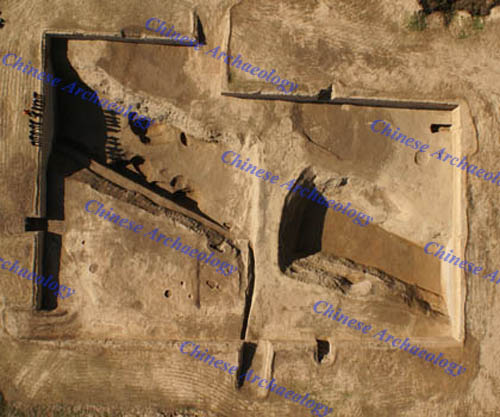
The YGZ site is 498 meters above the sea level, and is located on a terrace next to the Jing River, which belongs to a village of YGZ in Jijia Township, Gaolin County. From the northern side, the site is connected to Lei Village; and from the eastern side, it is adjacent to Xuwu Village. The Jing River is located 1km south of the 80 ha large site. The confluence of Jing and Wei rivers formed the Jingwei Delta, which is located 4 km east to the site. From the past four years, the total excavation area was more than 16,485 square meters and can be divided into the north and the south areas. Archaeological features include 49 house foundations, 896 ash pits, 9 ditches, 26 pottery kilns, 33 urn burials, 5 wells as well as 45 burials. Artefacts that can be reconstructed are more than 7000 pieces.
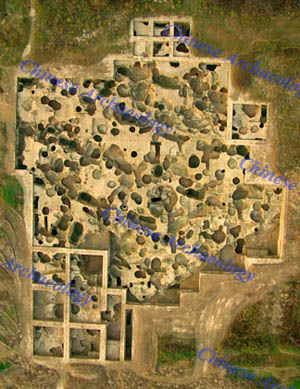
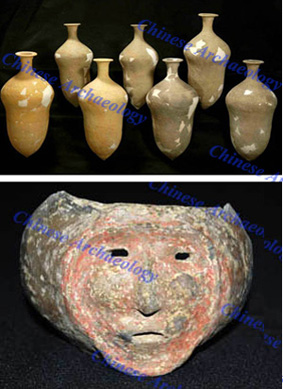
The southern excavation area is approximately 5,615 square meters. There are 23 house foundations of various kinds, 496 ash pits from Yangshao period, 10 pottery kilns, 8 urn bruials, 5 wells and also 31 burials from Han, Tang, Ming and Qing Dynasties. There are 5,273 potteries, 353 stone tools, 303 bone tools and 16 shell tools.
Prehistoric cultural deposits in the area belong to the Miaodigou(MDG) Culture and the Banpo IV Culture (BP4). The most important discovery was a series of house foundations and pottery kilns of BP4 located over the edge of a cliff in east-west alignment. There are altogether 17 house foundations shaped like the Chinese character “呂” (2 squares) with front and back structures. The front was in a ground structural design and the back was shaped like a cave, which can be regarded as the earliest cave structure. Next to the house foundations and kilns (H402), copiouIn order to facilitate the development of infrastructure, the Shanxi Provincial Institute of Archaeology has conducted an archaeological excavation in Gaolin district for more than 4 years since May 2004. Major discoveries were yielded at the Yangguanzhai (YGZ) Site.
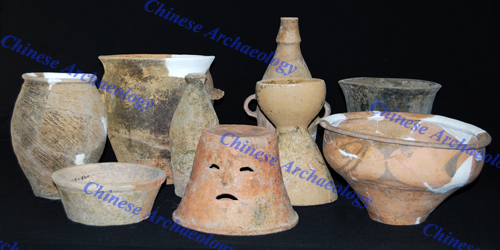
The YGZ site is 498 meters above the sea level, and is located on a terrace next to the Jing River, which belongs to a village of YGZ in Jijia Township, Gaolin County. From the northern side, the site is connected to Lei Village; and from the eastern side, it is adjacent to Xuwu Village. The Jing River is located 1km south of the 80 ha large site. The confluence of Jing and Wei rivers formed the Jingwei Delta, which is located 4 km east to the site. From the past four years, the total excavation area was more than 16,485 square meters and can be divided into the north and the south areas. Archaeological features include 49 house foundations, 896 ash pits, 9 ditches, 26 pottery kilns, 33 urn burials, 5 wells as well as 45 burials. Artefacts that can be reconstructed are more than 7000 pieces.
The southern excavation area is approximately 5,615 square meters. There are 23 house foundations of various kinds, 496 ash pits from Yangshao period, 10 pottery kilns, 8 urn bruials, 5 wells and also 31 burials from Han, Tang, Ming and Qing Dynasties. There are 5,273 potteries, 353 stone tools, 303 bone tools and 16 shell tools.
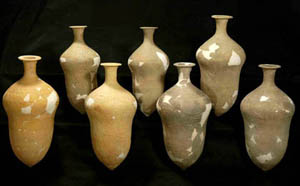 Prehistoric cultural deposits in the area belong to the Miaodigou(MDG) Culture and the Banpo IV Culture (BP4). The most important discovery was a series of house foundations and pottery kilns of BP4 located over the edge of a cliff in east-west alignment. There are altogether 17 house foundations shaped like the Chinese character “呂” (2 squares) with front and back structures. The front was in a ground structural design and the back was shaped like a cave, which can be regarded as the earliest cave structure. Next to the house foundations and kilns (H402), copious amount of pottery was unearthed, including 18 pointed-bottom pottery ping. Besides, huge amount of unburned debris and a wheel for pottery making were unearthed, which explained that the series of houses, kilns, and cellars were the elements formulating a pottery workshop.
Prehistoric cultural deposits in the area belong to the Miaodigou(MDG) Culture and the Banpo IV Culture (BP4). The most important discovery was a series of house foundations and pottery kilns of BP4 located over the edge of a cliff in east-west alignment. There are altogether 17 house foundations shaped like the Chinese character “呂” (2 squares) with front and back structures. The front was in a ground structural design and the back was shaped like a cave, which can be regarded as the earliest cave structure. Next to the house foundations and kilns (H402), copious amount of pottery was unearthed, including 18 pointed-bottom pottery ping. Besides, huge amount of unburned debris and a wheel for pottery making were unearthed, which explained that the series of houses, kilns, and cellars were the elements formulating a pottery workshop.
In order to facilitate the development of the sites, a rescue excavation was conducted from 2007 to 2008 in the north area. The excavation area was about 10,870 square meters till now and the major cultural deposit was from MDG. Archaeological features from this excavation include 26 house remains, 334 ash pits, 16 kilns and 24 urn burials. The most prominent discovery was a ditch of the MDG period settlement . After initial analysis, the ditch is trapezium in shape runs from south to north. The parameter of the ditch is about 1,945 and the interior area is 24,500 square meters with 6 – 9 meters wide (maximum width is 13 meters). The depth of the ditch is around 2 to 3 meters. From the western side of the ditch, there is an 2.7 meters wide entrance. Large nIn order to facilitate the development of infrastructure, the Shanxi Provincial Institute of Archaeology has conducted an archaeological excavation in Gaolin district for more than 4 years since May 2004. Major discoveries were yielded at the Yangguanzhai (YGZ) Site.
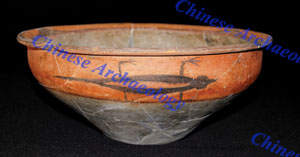
The YGZ site is 498 meters above the sea level, and is located on a terrace next to the Jing River, which belongs to a village of YGZ in Jijia Township, Gaolin County. From the northern side, the site is connected to Lei Village; and from the eastern side, it is adjacent to Xuwu Village. The Jing River is located 1km south of the 80 ha large site. The confluence of Jing and Wei rivers formed the Jingwei Delta, which is located 4 km east to the site. From the past four years, the total excavation area was more than 16,485 square meters and can be divided into the north and the south areas. Archaeological features include 49 house foundations, 896 ash pits, 9 ditches, 26 pottery kilns, 33 urn burials, 5 wells as well as 45 burials. Artefacts that can be reconstructed are more than 7000 pieces.
The southern excavation area is approximately 5,615 square meters. There are 23 house foundations of various kinds, 496 ash pits from Yangshao period, 10 pottery kilns, 8 urn bruials, 5 wells and also 31 burials from Han, Tang, Ming and Qing Dynasties. There are 5,273 potteries, 353 stone tools, 303 bone tools and 16 shell tools.
Prehistoric cultural deposits in the area belong to the Miaodigou(MDG) Culture and the Banpo IV Culture (BP4). The most important discovery was a series of house foundations and pottery kilns of BP4 located over the edge of a cliff in east-west alignment. There are altogether 17 house foundations shaped like the Chinese character “呂” (2 squares) with front and back structures. The front was in a ground structural design and the back was shaped like a cave, which can be regarded as the earliest cave structure. Next to the house foundations and kilns (H402), copious amount of pottery was unearthed, including 18 pointed-bottom pottery ping. Besides, huge amount of unburned debris and a wheel for pottery making were unearthed, which explained that the series of houses, kilns, and cellars were the elements formulating a pottery workshop.
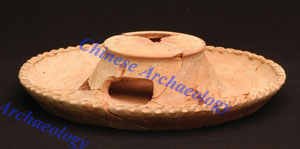
In order to facilitate the development of the sites, a rescue excavation was conducted from 2007 to 2008 in the north area. The excavation area was about 10,870 square meters till now and the major cultural deposit was from MDG. Archaeological features from this excavation include 26 house remains, 334 ash pits, 16 kilns and 24 urn burials. The most prominent discovery was a ditch of the MDG period settlement . After initial analysis, the ditch is trapezium in shape runs from south to north. The parameter of the ditch is about 1,945 and the interior area is 24,500 square meters with 6 – 9 meters wide (maximum width is 13 meters). The depth of the ditch is around 2 to 3 meters. From the western side of the ditch, there is an 2.7 meters wide entrance. Large number of artecfacts including potteries, bone and stone tools were located on both sides of the entrance (H776 and G8-2). Artefacts including basin with human face decoration, painted pottery basin with animal design as so forth, which are rarely seen in China. As to obtain further information from the site and analysis the characteristic of the ditch, an extended excavation has been conducted. From the southwestern corner of the ditch (G8-4), a huge pottery figurine was discovered. The archaeological excavation in is still in progress.
From the previous excavations in YGZ site, a better understanding of settlement distributions from various periods is achieved. The northern elevation of the site is higher than the south. The southern part of the site is the settlement of BP4 period whereas the northern part is the settlement of MDG.
Huge amount of relics of the BP4 culture further enriched the cultural exchange especially in the confluence of Jing and Wei Rivers. Discovery of pottery workshop composed of house foundations, pottery kilns and cellars indicate that the practice of division of labour is being adopted during that period. Furthermore, the use of cellar and storage explained the idea of private ownership has existed. These findings are significant when studying the social structure of that particular period.
The ditched MDG settlement of in the northern side of the site is the only well preserved settlement of its kind. Those provide valuable information for the analysis on the of settlement pattern and social structure of the MDG culture. The parameter of the ditch is 1,945 meters and its interior area is 245,790 square meters. This massive ditch settlement is rarely seen in China.

